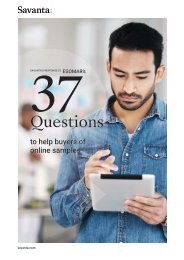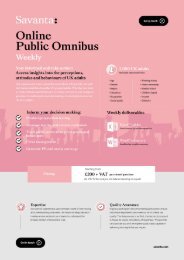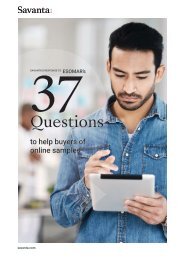Savanta_37_online_sample_questions_US
You also want an ePaper? Increase the reach of your titles
YUMPU automatically turns print PDFs into web optimized ePapers that Google loves.
<strong>37</strong> QUESTIONS TO HELP BUYERS OF ONLINE SAMPLES<br />
Sampling and project management<br />
12. Briefly describe your overall process from invitation to survey completion.<br />
What steps do you take to achieve a <strong>sample</strong> that “looks like” the target<br />
population? What demographic quota controls, if any, do you recommend?<br />
Panelists or participants can be invited to join through direct emails or by clicking on<br />
a link provided on a website or application. Every invitation includes the opportunity to<br />
take the survey, details about the incentive, an estimated completion time, terms and<br />
conditions, privacy policy, and the option to opt-out, along with explicit instructions on<br />
how to start the survey, and a link to begin.<br />
When starting the survey, respondents are required to meet certain criteria through<br />
screening <strong>questions</strong>. Once they have met the criteria, they must answer all mandatory<br />
<strong>questions</strong> in the survey and submit their responses to receive the incentive.<br />
<strong>Savanta</strong> uses nationally representative quota controls based on the latest census<br />
data, to ensure that the <strong>sample</strong> population accurately reflects the demographics of the<br />
entire country. This approach helps to minimize bias and ensure the findings are more<br />
generalizable to the overall population.<br />
If more targeted groupings are required, <strong>Savanta</strong> will collaborate with the client to create<br />
quotas that work for their required audience. For example, if the research is focused on<br />
a specific region or demographic group, client-specified quotas can be set to ensure an<br />
adequate representation of that particular group.<br />
<strong>Savanta</strong> will use interlocked quotas when multiple demographic variables need to be<br />
controlled simultaneously. This allows for greater precision in selecting participants who<br />
match specific combinations of demographics. Non-interlocked quotas are used when<br />
only one demographic variable needs to be controlled, such as age or gender.<br />
Overall, the choice between nationally representative or client-specified quotas and<br />
nested or non-nested structures depends on the specific objectives and requirements of<br />
the research project. It is important to carefully consider these factors in order to ensure<br />
the <strong>sample</strong> is representative and the study outcomes are reliable.<br />
savanta.com<br />
7

















